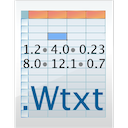PREFERENCES...
⌘, This window lets you select your preferences for program appearance and functions. Chose one of four tabbed categories: Appearance, Sounds, Printing, File Handling, and Operations.

The Graphics file format for window printing buttons select whether you want to print copies of graphics windows (such as the main data channels, or the file information window) in .pdf, .png, or .jpg (jpeg) format. Any of these can be independently set to a printer, although you can't do that directly from within LabAnalyst.
TEXT FILE TYPES: There are two common text formats used in spreadsheets (comma-separated variables; .csv, or tab-separated variables; .txt) for the 'spreadsheet' text files generated from several analysis or edit modes. These can be read by spreadsheet-handling programs such as MS Excel, or by many kinds of statistical or graphing applications (e.g., JMP, Kaleidagraph, etc.).

The .Wtext option produces files with the same file format as .txt, but files will appear with a unique icon (shown at right). This can be useful to keep your Warthog text files visually distinct from other .txt files. However, .Wtxt is not recognized as a readable file type by MS Excel or other spreadsheet apps until you do the following:
- Highlight any .Wtxt file.
- Hit '⌘-I' (or use the 'Get Info' option in the Finder's FILE menu).
- In the Info window, find the 'Open with:' option and use the popup menu to select MS Excel (or Numbers, or any other spreadsheet app) -- if one doesn't appear, select 'Other...', find your spreadsheet app, and select it.
- Finally, click the 'Change All...' button to apply your choice to all .Wtxt files.
This sounds a bit tedious but you only have to do it once, and subsequently you can double-click or drag-and-drop .Wtxt files and they should load correctly.
The Plot Style button lets you set the foreground (data), background, and label and marker colors on the plot and block windows (this is available only when a data file has been loaded).
To avoid having to re-set your preferences at every launch, click the Store Preferences button to store your current settings (including screen colors, current values of FiO2, FiCO2, and RQ, etc.). When launched, LabAnalyst reads the preferred settings and uses them as defaults.
The Export button lets you save a copy of your preferences external to the LabAnalyst application package, where it normally resides. This is useful if you want to save your preferences before updating LabAnalyst, which comes with a generic set of preferences. Once you have installed the new LabAnalyst version, use the Import button to restore your old settings (be sure to click the Store Peferences button to save them into the application package).
|

